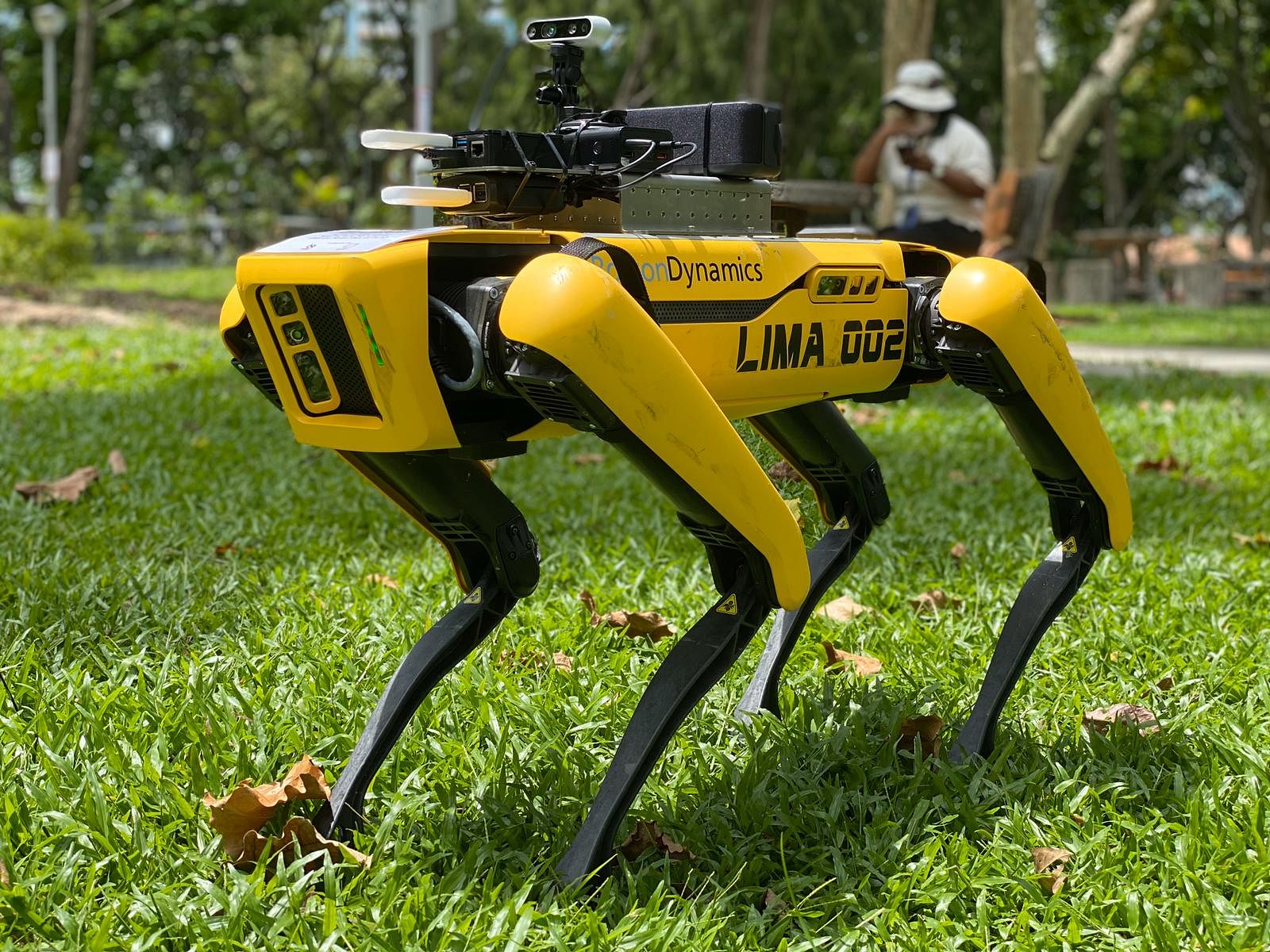BRANDED CONTENT
Big push for AI proves fruitful and useful
Artificial intelligence, smart sensors and data science have proven to be vital in helping Singapore to achieve its Smart Nation vision

Singapore’s Smart Nation transformation aims to better harness technology to empower and improve lives. PHOTO: GETTY IMAGES
Jeremy Theseira, SPH Content Studio
Follow topic:
Singapore is stepping up its momentum in using data analytics, artificial intelligence (AI) and sensors to make lives easier, safer and smarter.
And the impact is being felt in everything from the fight to contain the Covid-19 outbreak to security to water conservancy and even food safety.
The latest initiatives follow the launch of the National AI Strategy by Deputy Prime Minister and Minister for Finance Heng Swee Keat at the Singapore FinTech Festival last November.
The strategy maps out how Singapore will develop and deploy AI solutions to transform the economy and improve lives.
The National AI Strategy focuses on five key areas - healthcare, security, smart estates, education and logistics - and is led by the National AI Office, a unit created under the Smart Nation and Digital Government Office.
This year, the Government will invest over $710 million in infocomm technology projects that involve the use of data analytics, AI and sensors to deliver better government services.
Some of the areas where results are already beginning to show in real time are in:
- Using AI and robots in the fight against Covid-19
- Using analysis for better Covid-19 contact tracing
- Using smart robots for patrol and surveillance
- Using smart sensors and meters to save water
- Using data analytics for tourism insights
VigilantGantry on guard against Covid-19
A recent example of using AI-powered video analytics is VigilantGantry, which automatically screens temperatures of individuals passing through a gantry or entrance with a regular video camera and thermal scanner.
The software can detect and screen the temperatures of those wearing caps or items that cover their foreheads. VigilantGantry can also be integrated with existing infrastructure such as gated entrances.
Another key feature: Its thermal scanner is designed to be modular so that industries from the private sector can easily incorporate the technology and open-source software into existing infrastructure, such as gated entrances of venues.
Developed by the Government Technology Agency (GovTech), VigilantGantry was tested at the National University of Singapore before being piloted at Changi Exhibition Centre.
The exhibition centre had, on April 25, been repurposed into an integrated community care and recovery facility for recovering or mildly symptomatic Covid-19 patients.
VigilantGantry will soon be set up at more public places, large-scale events and at government buildings.
SPOTON for hot spots
GovTech also developed SPOTON, a mass temperature screening solution for venues with little infrastructure support.
SPOTON can screen the temperatures of up to 10 people at once. It was first tested at NTUC Club's Downtown East and has been deployed at several buildings, including the Supreme Court and Parliament House.
The Islamic Religious Council of Singapore (Muis), Housing and Development Board and JTC Corporation have also used SPOTON for their operations.
With GovTech's plans to license SPOTON's software, companies from the private sector will soon be able to include the proprietary software in their existing thermal scanning solutions.
Robodog adds bite to Covid-19 fight
In the fight against the spread of Covid-19, a yellow and black robot dog has been raising eyebrows at Bishan-Ang Mo Kio Park.
The robot, named Spot, first stepped foot in the park in May. Its job was to patrol and politely remind park-goers to keep a safe distance of at least 1m apart.

Part of a two-week trial by the National Parks Board and Smart Nation and Digital Government Group, Spot is one of many technology-based innovations that has helped to ease the strain on manpower during the Covid-19 pandemic.
The robodog, which was originally developed by American company Boston Dynamics, is more than a loudhailer on four legs. GovTech further enhanced Spot with features such as remote control, 3D-mapping and semi-autonomous operations.
Unlike wheeled robots, Spot works well across different terrains and can navigate obstacles, making it ideal for use in public parks. The robodog can also carry up to 15kg worth of sensors and components.
GovTech is now working with various government agencies to develop new capabilities and explore other uses for Spot, such as carrying out hazardous inspection works.
Analysis tool assists contact tracing
The Defence Science and Technology Agency (DSTA) has developed a network analysis tool to help make the Singapore Armed Forces' contact tracing efforts more effective.
The network analysis tool, which was first tested in early April, uses information compiled by contact tracing centres to create a visual network representation of confirmed coronavirus cases with data analytics.
The coronavirus clusters at night club Ce La Vi, Black Tap at Marina Bay Sands and Mustafa Centre were identified with the help of DSTA's network analysis tool.
O-R3 on watch at reservoirs
For PUB's reservoirs, there is O-R3. Developed by local technology company Otsaw, outdoor security robot O-R3 was originally part of a pilot trial by PUB to enhance monitoring and surveillance operations at its plants and reservoirs

The robot, which was first tested in May last year at Bedok Reservoir, features a 360-degree camera and sensors that record and process data for PUB officers.
By end-April, O-R3 had been used to patrol and broadcast safe distancing messages to visitors of Bedok Reservoir and Pandan Reservoir.
Matar moves and sees all
Spot and O-R3 are not the only smart robots on patrol duty in Singapore.
The Singapore Police Force's (SPF) Multi-purpose All Terrain Autonomous Robot, or Matar, moves about autonomously and provides Police Command Centres with real-time surveillance via a 360-degree video feed.

Matar is designed to operate at places with high human traffic as it is able to navigate stationary and dynamic obstacles along its patrol route.
It was jointly developed by the SPF and the Home Team Science and Technology Agency (HTX), in partnership with ST Engineering and the Agency for Science, Technology and Research.
It has been used as part of the police's patrol and security surveillance efforts at large-scale events such as the National Day Parade, Marina Bay Countdown and the Chingay Parade.
Like Spot, Matar has audio communication functions for relaying messages on safe distancing measures.
"The robots can patrol and navigate without anyone using a remote control or guarding it," said Mr Ong Ka Hing, deputy director of HTX's Robotics, Automation & Unmanned Systems.
"This minimises the need for front-line officers to get in close contact with others, providing some protection against infection for officers at the isolation facility."
Mr Ong was part of the team that built Matar and served as the technical advisor of its deployment during the Covid-19 period.
He added that such technological advancements are meaningful as they protect lives.
Smart meters to save water
PUB will be rolling out smart water meters across the country in phases from 2021.
Similar to fitness trackers, smart water meters allow residents and businesses to track important data in real time and receive updates.
Users can track in real time their water usage via an online customer portal, and be alerted about high water consumption and potential leaks.

Early smart water meter trials in 800 households in Punggol and Yuhua in 2016 and 2018 respectively have shown positive results. Households reported water savings of up to 5 per cent from being alerted to leaks and from adopting water-saving habits.
Mr Ridzuan Ismail, PUB's director of Water Supply (Network), said: "The smart water meter is a prime example of how we can leverage technology to significantly improve our productivity as we do away with manual meter reads."
PUB's smart water meters are part of GovTech's Smart Nation Sensor Platform (SNSP), a Smart Nation strategic national project.
SNSP provides whole-of-government products and services for collecting, sharing and analysing sensor data, and managing Internet of Things and robotics systems.
With real-time sensor data, SNSP is able to unlock insights for government agencies, the private sector and citizens to make data-driven decisions that improve the quality of life.
The SNSP has also supported traffic planning and operations with the Lamppost-as-a-Platform (LaaP) project, effectively turning street lamp posts into a network of wireless sensors.
Now on trial at one-north and Geylang, selected lamp posts are fitted with cameras and sensors to collect data on the environment, monitor the use of personal mobility devices in public spaces, and carry out crowd analytics for urban, event and transport planning.
OTHER INNOVATIONS
Insights on tourism
The Singapore Tourism Board (STB) has started transforming the industry with a central data analytics platform known as the Singapore Tourism Analytics Network, or Stan.
The tool provides tourism-related businesses and stakeholders with tourism statistics and data-driven actionable insights, to aid them in business planning and strategy.
Capability building programmes and training courses on data analytics will be made available to help companies build their capabilities in data analytics to meet their business needs.
Getting smarter about food safety
The use of smart technology to enhance food safety will be explored at the Singapore Food Agency's (SFA) new Food Safety Experimentation Laboratory, which is targeted to be up and running by 2021.
Among other possibilities, the lab may use augmented and virtual reality to simulate import and inspection processes and experiment with web-connected devices on food appliances to ensure appropriate temperatures for food.
Video analytics systems may also be developed and tested to automatically flag potential issues during food preparation from food establishments' closed-circuit television footage.
SFA is also exploring the use of rapid diagnostic tools to quickly detect food-borne pathogens in food establishments. These systems will work in tandem to flag food safety issues before food reaches our plates.
This article is part of a series by GovTech on the re-engineering of the Government's operating system to provide faster and better public services.

